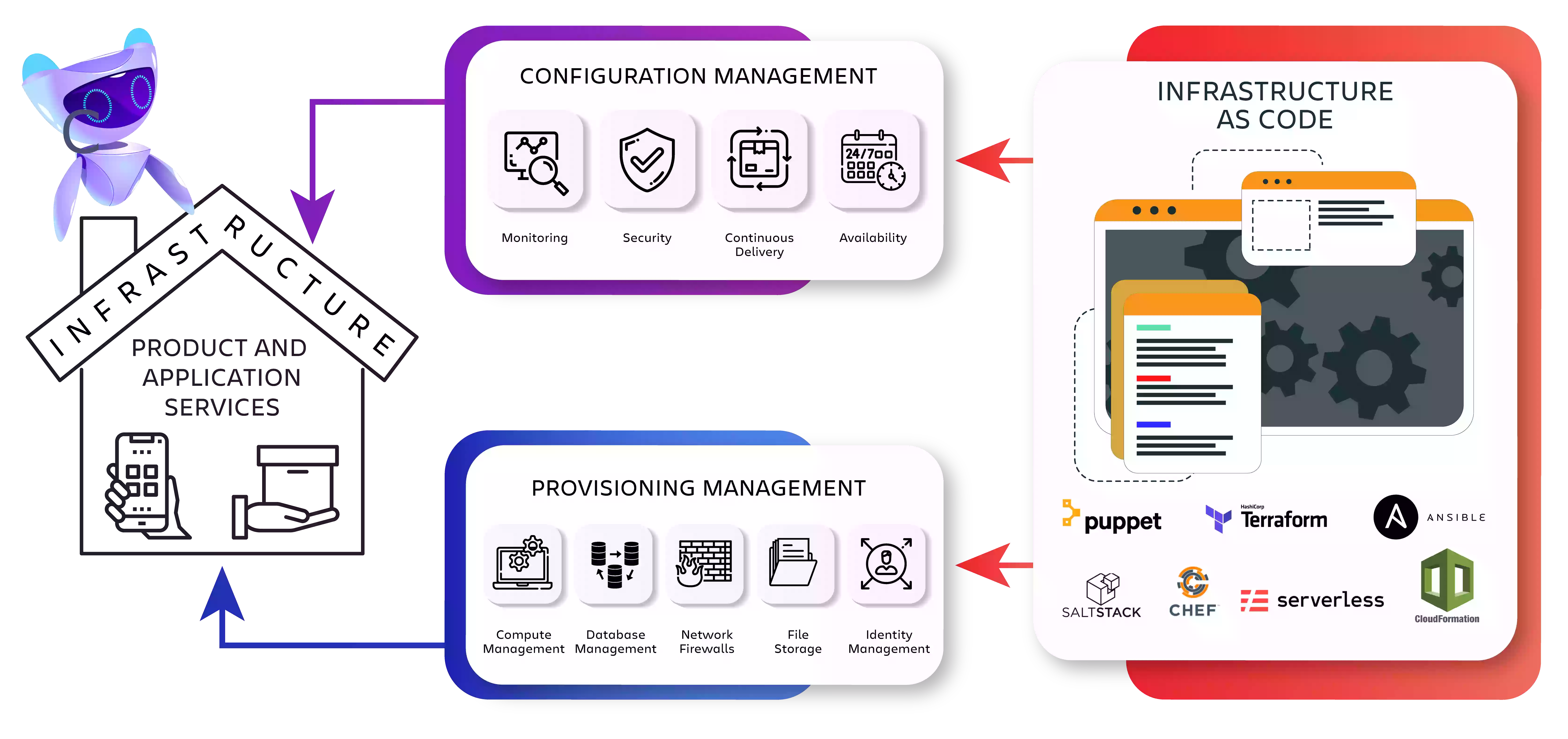Infrastructure As Code
- Home
- Services

So what is the big deal with Infrastructure as Code anyway?
Infrastructure as Code, or IaC for short, has revolutionised how IT systems are deployed into the public cloud, paving the way for many new technologies that save businesses time and money.
Infrastructure as Code (IaC) refers to a collection of scripted tools that makes managing, provisioning, configuring, and replicating cloud resources much more effortless.
Over the last decade, the public cloud has provided tremendous benefits to businesses by making it easier and less expensive for companies to leverage the latest technology for their IT infrastructure. Using a standard internet browser, one can quickly and easily create cloud resources in services such as Amazon Web Services (AWS), Azure, or Google Cloud. You can have this server up and running for your web application in just a few mouse clicks.
However, when we need to add complex features such as cloud security or networking and start deviating from the default web settings, a problem arises. Manually clicking through the console (or what most users traditionally call terminals) becomes tedious, frustrating and error prone.
Even after the cloud resources are up and running, there is usually a lot of configuration that needs to be done at the Operating System level, including the deployment of any applications that need to run on the servers. This frequently entails either manually configuring software or writing bespoke OS-dependent scripts, both of which take a long time to develop, maintain, and deploy.
This is where infrastructure as code comes to the rescue.
Terraform scripts are one of the many IaC tools that can provide virtually any hardware infrastructure on various cloud platforms. Another such tool is AWS CloudFormation, which specialises in working only within the AWS infrastructure. These tools are intended to generate immutable resources that do not change significantly once created and classified under the provisioning management.
On the other hand, Ansible, Chef, and Puppet are IaC tools that manage things that may change regularly in the infrastructure due to changing application requirements. They can be used to dynamically configure operating systems and application software environments on infrastructure over the course of the resource lifetime. These tools are classified under configuration management.
Ansible, Chef, and Puppet, on the other hand, are IaC tools that manage things that could change regularly in the infrastructure due to changing application requirements. They can be used to dynamically configure operating systems and application software environments on infrastructure over the course of the resource lifetime. These tools are classified under configuration management.
Even though these technologies are classified as provisioning and configuration management, they overlap substantially. This can make it challenging to determine which tools to use when. A provisioning management tool, such as Terraform, can, for example, be used to configure an operating system, and Ansible, a configuration management tool, can be used to generate immutable infrastructure.
Later in this article, we discuss selecting the best tool for the job. But first, look closely at why you want to use infrastructure as code with your cloud-based systems. What are some tangible benefits of using the infrastructure as code tools described above?
Build and replicate faster and consistently
When there is a need to duplicate and scale infrastructure resources, IaC provides a significant benefit. When all your infrastructures are coded, instead of doubling the manual effort for duplication, everything can be redeployed repeatedly by code with a few simple commands. The additional deployments are likely consistent with the original, with a significantly lower chance of error.
Finding and debugging bugs is also easier since searching a few code pages is more straightforward than scrolling through hundreds of configuration options over several console pages.
Speed up software development lifecycle
Identifying and resolving issues dramatically reduces development lifecycles, especially as architectures evolve over time.
It is easier to add new Infrastructure because many existing IaC templates for various boilerplate architectures can be repurposed. AWS QuickStart, for example, is a collection of CloudFormation templates that can be reused to generate infrastructure deployments for different everyday use cases.
Reduce management overhead and maintenance
Maintaining Infrastructure is a hidden cost in all IT systems that can add up over time. Failure of a system component is unavoidable at some point because new viruses or vulnerabilities in operating systems and dependent software emerge every day.
As a result, IT Infrastructure has both immutable components that are susceptible to failure and mutable features that require constant updates and maintenance. Because changes may be deployed in minutes rather than hours, Infrastructure as Code can dramatically reduce downtimes and encourage more frequent iterative upgrades in environments. Some of these tools have rollback functionality that can prevent a crisis from arising due to insufficient testing before deployment.
Having everything written in code may also be regarded as a form of inventory of all the cloud resources being used. You can keep track of what you use this way, making it easy to analyse consumption, anticipate costs, and make decisions.
Collaborate changes through source control
To all 21st-century coders, source control is a godsend. Tools such as GitHub have enabled several developers to work collaboratively on different pieces of Code and keep track of the changes they make simultaneously.
While working on separate areas of the system architecture using Infrastructure as Code, developers can track one other's progress. Using certain best practices in modularising Infrastructure as Code can also help decouple different infrastructure environments used for various business units while minimising technical debt.
Optimise on Costs
Infrastructure as Code, like any other programming paradigm, can be automated with CDCI. Developers can use it to launch Infrastructure by producing triggers from their source repository. As a result of this capability, the Infrastructure and apps it houses can be launched on-demand and destroyed when no longer required.
Automating infrastructure delivery as Code takes advantage of the cloud's on-demand nature to reduce resource costs. Temporary Infrastructure can be set up for tasks that occur for short periods. Scheduled batch computing tasks and automated test servers, which require dedicated Infrastructure, are examples of use cases of this.
How does one choose an Infrastructure as Code platform?
So, how do you decide which platform to use? Is it possible to select a single infrastructure as a code language that can do everything?
Yes, it is possible in theory to use a single tool, such as Terraform, to perform all provisioning and configuration management. What you will discover, however, is that developing configuration management modules with Terraform will take longer than with tools like Ansible for all but simple cases.
Each tool has different strengths and weaknesses. Terraform employs a declarative language known as HCL, which is ideal for describing immutable objects.
To configure the software running inside Terraform resources, you'll quickly find yourself knee-deep in PowerShell or bash scripts. On the other hand, Ansible does configuration exceptionally well by using reusable YAML playbooks, a much cleaner and more straightforward approach deployed across multiple platforms
In practice, combining the strengths of several tools to implement your Infrastructure using Code is very common. To reduce technical debt, Canditude has worked on smaller projects that may use only a single provisioning management tool, such as Terraform, at first. But then, as the requirements grow, we evolve the architecture by introducing configuration management tools, such as Ansible, allowing us to take advantage of each tool's strengths.
The disadvantage of using multiple tools, mainly carelessly, is the accumulation of unneeded technical debt. Experience has shown that there is no one-size-fits-all solution, and selecting the appropriate IaC tools must be in sync with both technical needs and the business's short and long-term goals.
What does the future hold for Infrastructure as Code?
Infrastructure as Code is still a relatively new field, with new practises and tools emerging rapidly to meet the needs of modern digital transformation. One emerging trend is the creation of Cloud Development Kits (CDK). These are libraries that generate IaC. They are written in widely used languages such as Python and Typescript, commonly known by developers.
This means developers and cloud solution architects do not have to learn new IaC stacks to provide Infrastructure. They can also benefit from the flexibility provided by these well-established programming languages.
How do I get started with IaC in my business?
You now have a better understanding of how powerful IaC is to the cloud. Where do you begin to start leveraging its power? What kind of people do you hire? Learning Infrastructure as Code is similar to learning any other technology stack, with one important exception. Because IaC generates underlying cloud resources, the engineer must be well-versed in cloud architecture and best practices. This includes comprehending and implementing the Well Architected Framework principles to ensure the Infrastructure can meet availability, reliability, and resilience objectives defined by product and organisational requirements.
This entails broadening and deepening one's knowledge of cloud technologies such as networking, security, computing, databases, monitoring, and many others. This is an exciting area to learn because there are so many options for each area, but it can also be very intimidating for development teams who want to focus on building their product. If done in silos and without considering the needs of various business stakeholders, it could also add a significant layer of technical debt and operational inconsistencies, leading to inconsistent product or service quality.
Learning about Infrastructure as Code and the underlying Infrastructure usually diverts the team's attention away from the core expertise they provide to the business. These infrastructure projects typically necessitate significant short-term endeavour to migrate using IaC, followed by a lighter supporting effort for incremental improvements and operational maintenance. The knowledge gained from these efforts is typically transferrable and thus does not necessarily add to the skills the organisation requires to develop its area of core expertise.
Canditude, for example, offers businesses a long-term partnership with the expertise to develop, evolve, and maintain their cloud-based Infrastructure through a collaborative and DevOps culture. Canditude can scale its level of support to meet your business needs and help maintain consistency across teams and organisational silos as your development organisation grows. As a result, your teams can focus on innovating around your core competencies while Canditude automates your cloud-based Infrastructure and boosts development productivity behind the scenes.
Schedule a friendly chat with a solutions architectAbout the Author
Sayuj Nath is a cloud solutions architect and a founder at Canditude. He has extensive experience in the design and implementation of cloud-based system architectures using a broad range of Infrastructure as Code platforms such as Terraform, CloudFormation and Ansible.
When it comes to helping engineers innovate and get to market quicker, Sayuj has a deep understanding of what it takes to drive productivity and meet business objectives using DevOps principles and cloud native infrastructure. He has worked with a wide range of engineering teams from industries such as financial services, energy, biomedical, defence, education, dairy and mining.

